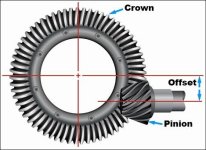msmith1wa
Member
Same thing just less down force on the front tires.
I am going to propose something that is not practical but takes what SPYDERLK is saying a little further.
Lets say there is an object that is to heavy or is theoretically immovable. Now lets dig a trench out from this object. Now fabricate a hitch that has the pull point below ground level. Now back the tractor up to the immovable object so that the trench is between the tires so that the hitch can be installed without dragging. Now pull on the immovable object with the tractor.
Will the tractor lift the front tires and tip over backwards? No it will not, in fact it will do just the opposite and actually force the front tires into the ground.

As soon as the tire's stop moving the front of the tractor goes up. It requires sufficient torque and the rear must have enough traction so they rotate more slowly than normal for the gearing being used.:thumbsup:
The force contributed by the drive shaft must be included in the sum of forces and acts at the point the pinion contacts the ring gear.p:thumbsup:
Why do some four wheel drive tractors have weights on the front when just the fact the tractor is hitched low and pulling would do the same thing?
Do yourselves a favour and look at a picture of a ring gear and pinion. What happens when the ring gear is locked in position as would be the case with sufficient traction!
View attachment 371314
:thumbsup: With a little scrutiny it can be noted that within the consolidated chassis every up force has a corresponding down force.I can say for certainty that the ring and pinion forces are completely resolved INSIDE the tractor. The pinion climbing the ring can absolutely NOT cause the front of the tractor to lift.
All rotation is due to the reaction with the tires on the ground. PERIOD! (the wheels are commonly driven by a ring and pinion, but there are alternate configurations.)
Using the example suggested by Egon and the photo.
Quote:
Do yourselves a favour and look at a picture of a ring gear and pinion. What happens when the ring gear is locked in position (as would be the case with sufficient traction!) [end]
But this time, lock the ring INSIDE the differential housing, weld the tractor axles to the cases somehow ;-) Just don't allow the torque to get out.
The ring gear is LOCKED in position, but does the front of the tractor lift? NOT A FRACTION it doesn't. Something will break, but the tractor won't show a thing in it's motion or weight bias.
Any and all "ring climbing" is resolved within the transmission housing.
Hmm.. What keeps two wheeled tractors from being nothing more than a lumpy roto-tiller ? Is the pulling reaction taken out to the draw bar some how? A sleeve hitch or the like?
No. You are misinterpreting your experiences. That easy explanation is wrong. Its the combination of drive lever and load lever as explained in prior posts.-- And on hills the position and height of the center of mass becomes much more important than in level situations because it affects the load lever.I cannot recall the number of times I've hitched at tractor to an object, applied power to the rear tires and had the front tires lift off the ground.
Every time the hitch point is high enough to cause the rear tires to attain the necessary amount of traction required to lift the front tires, they will lift.
If you have never experienced this, then I suggest that you do your own experiments with your own tractor hitched to an object it cannot pull and you will too experience this function. Put a 3pt drawbar on your tractor, hitch it to a tree or something it cannot pull, put the tractor in low gear, with the 3pt lowered and start pulling. The tractor will spin it's tires. Start slowly raising the 3pt while spinning. Eventually the front tires will lift off the ground. More height, more front tire lift. What is causing that??
There's no magic or long drawn out explanations with graphs and charts, there's just nature. The pinion gear will climb the ring gear and the front of the vehicle will rise.
I am surprised that mechanical oriented persons would not know this simple fact of nature.
No flaming here. Just simple logic experienced over many years of mechanical use.
Same laws apply when I've got my buggy on a vertical incline trying to climb it, specific application of power is required to avert disaster. Wonder why that is?? It's because the pinion gear is climbing the ring gear, which will ultimately tip the vehicle over backwards. Have experienced that. It's not pretty. Has nothing to do with being hitched to anything. Just simple mathematics.
]Matching downward force on the ring gear face and bearings.] Net effect ZeroAs soon as the tire's stop moving the front of the tractor goes up. It requires sufficient torque and the rear must have enough traction so they rotate more slowly than normal for the gearing being used.:thumbsup:
The force contributed by the drive shaft must be included in the sum of forces and acts at the point the pinion contacts the ring gear.p:thumbsup:
Why do some four wheel drive tractors have weights on the front when just the fact the tractor is hitched low and pulling would do the same thing?
Do yourselves a favour and look at a picture of a ring gear and pinion. What happens when the ring gear is locked in position as would be the case with sufficient traction!
View attachment 371314